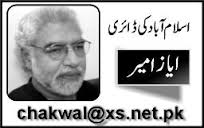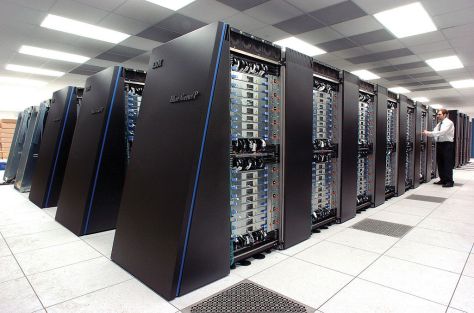Musharraf and the media
Ayaz Amir
Friday, December 06, 2013
From Print Edition
Musharraf and the mediaWhat exactly is our problem when it comes to discussing the status of the media? Do we suffer from short memories? Or are we purposely selective with the truth?
The Pakistani media today is more electronic than print…meaning to say that the electronic component in terms of reach and influence outweighs its print counterpart. Newspapers existed since 1947 and before. The rise and spread of the electronic media is a recent phenomenon.
How did this come about? Private TV channels, now a part of our lives and often not for the best, did not descend from the heavens. They were not conjured out of thin air. It lay with the government of the day, headed by one Gen Pervez Musharraf, to allow or disallow them. It was his decision, his alone, to allow them and give them the freedom they have. Why is it so hard for some people to swallow this fact? Does it injure their self-esteem?
Other failures can be placed at Musharraf’s door, for which he has paid a heavy price. But for being the godfather of the modern Pakistani media, how can anyone in his right mind deny him the credit? This used to be an impoverished profession. I remember Mushahid Hussain telling me – this was in 1979-80 – that Chaudhry Saab, ghar ke daane hon toh journalist ban sakte hain, meaning thereby that private means were necessary in order to survive as a journalist.
I used to work my back off writing my first columns for the weekly Viewpoint – typing, revising and rewriting – and getting Rs75 per column, and thinking when I received my cheque that manna had fallen from the skies. The fat salaries this profession now enjoys, or at least its top-rankers enjoy, is because of one person and the decision he took: Musharraf. Let no scribe or anchor on horseback forget this.
Pakistan’s democrats – Benazir Bhutto, Nawaz Sharif – could address huge public gatherings. As prime ministers they never could put themselves to the test of live TV press conferences. Love or hate him, Musharraf was the first Pakistani leader to do so
Not that journalists have not struggled for press freedom. They have and mightily too. Journalists have died in the line of duty. But that is not the same thing as saying that it was because of some heroic struggle that the electronic media got the space it now has.
As army chief and military dictator Musharraf was very much his own master, especially with the political parties in disarray and top leaders out of the country. And many journalists, later to become fierce champions of democracy and freedom, were not averse to eating from his hand and dancing to his tune.
Add to this his own sense of comfort with the media and he felt no qualms in letting the media or information revolution come to Pakistan. Apart from anything else, it lent an air of respectability to his regime. Here was a military man allowing this much media freedom…this played wonderfully in the west.
In any event, big media houses, not working journalists, were the first to enter this field, followed by captains of industry and even characters with less than clean backgrounds. These elements did not put a pistol to Musharraf’s head to get their TV licences.
Military regimes, and even civilian governments (remember Bhutto), had been known for curtailing press freedom. Here was a military man opening up media space. Hang him for his sins by all means but, if hearts not be that small, allow him the good he may have done.
It is the untutored mind which sees things in black and white. No one put more stringent curbs on the press than Gen Zia. In his time we saw censorship and even pre-censorship, and journalists imprisoned, and three of them flogged. But there was another side to Zia as well. In those days government permission was necessary for newspapers to appear, as per the infamous Press and Publications Ordinance. Zia allowed The Muslim to appear from Islamabad, the Frontier Post to come out from Peshawar and Lahore, the Nawai Waqt to come out from Karachi, the Jang to take out an edition from Lahore.
So we have this paradox: the father of censorship, the father of flogging, allowing this press expansion. Zulfikar Ali Bhutto should have allowed this expansion, but he did not, he having a very thin skin when it came to criticism.
And the Press and Publications Ordinance was done away with not by any elected leader but by Illahi Baksh Soomro when he was interim information minister in the cabinet installed by Zia after he had dismissed Muhammad Khan Junejo as prime minister (but, if memory serves, Soomro did this after Zia was dead and safely buried).
We remember Ayub Khan for the folly of the 1965 war and the popular movement which dislodged him from power (although, as much evidence suggests, Bhutto and Gen Yahya schemed in tandem to get rid of Ayub). But Ayub also had achievements to his credit, Pakistan doing well under his watch until the 1965 war.
Yahya is remembered for his drinking, his mistresses and the infamy of the 1971 war. But he undid One Unit, which was a popular demand, and held the country’s first general election. And at the Rabat Islamic Conference he stoutly resisted the move to give India observer status. The aftermath of the 1970 elections proved too much for him. Perhaps it would have proved too much for anyone.
Closer home, we see Chief Justice Chaudhry criticised for excessive suo-motuism and interfering in executive matters. But he has made the judiciary strong and put searching questions to institutions hitherto considered sacrosanct and untouchable. When all else is forgotten this will be remembered. (Take the swift reinstatement by the Islamabad High Court of the sacked Nadra chairman, Tariq Malik. In the Pakistan of old such a thing would not have happened. It is the Chaudhry-engendered climate in which this becomes possible.)
It is a bit amazing therefore to see bar councils dithering over the question of whether to dine out My Lord Chaudhry when his time is up. Have a heart, black-coat comrades. If Chaudhry doesn’t deserve to be bid farewell in style no one does. For good or ill, he has left his mark on our times and another like him, good points and bad, will not come that quickly. Churlishness will not diminish his stature. My lawyer friends will look small.
But to return to my argument…to dwell on past contradictions is to point out the obvious: that good and bad co-exist side by side. This is part of the human condition.
Guys like me have written at length, perhaps more than others, about the baneful effects of military rule. There is no shortage of journalists of the old school, of the Zia days really, who have seen the insides of prisons. But none of this should be a licence for writing fiction and subscribing to fairy-tales that would have the younger generation believe that the space enjoyed and sometimes misused by the electronic media today was won in a Battle of Stalingrad waged by the fearless defenders of the fourth estate. This is a beguiling tale but, alas, like most fairy-tales not true.
By the time of the lawyers’ movement Musharraf’s brilliant idea of TV channels by the dozen and saturation news coverage had come back to hit him, he himself becoming the first and principal casualty of the thing he had helped create. That takes away nothing from the fact that even though a military dictator he did what every ruler before him, military or civilian, had feared to do: give free rein to the electronic media. Among a multiplicity of failures this must count as some achievement.
If the media today has different problems – it can criticise the army and ISI but knights of the media become very cautious when it comes to entities like the Taliban and the MQM – that is no fault of Musharraf’s. These are self-imposed fears, or limitations imposed by the rigour of the times.
Email: winlust@yahoo.com


